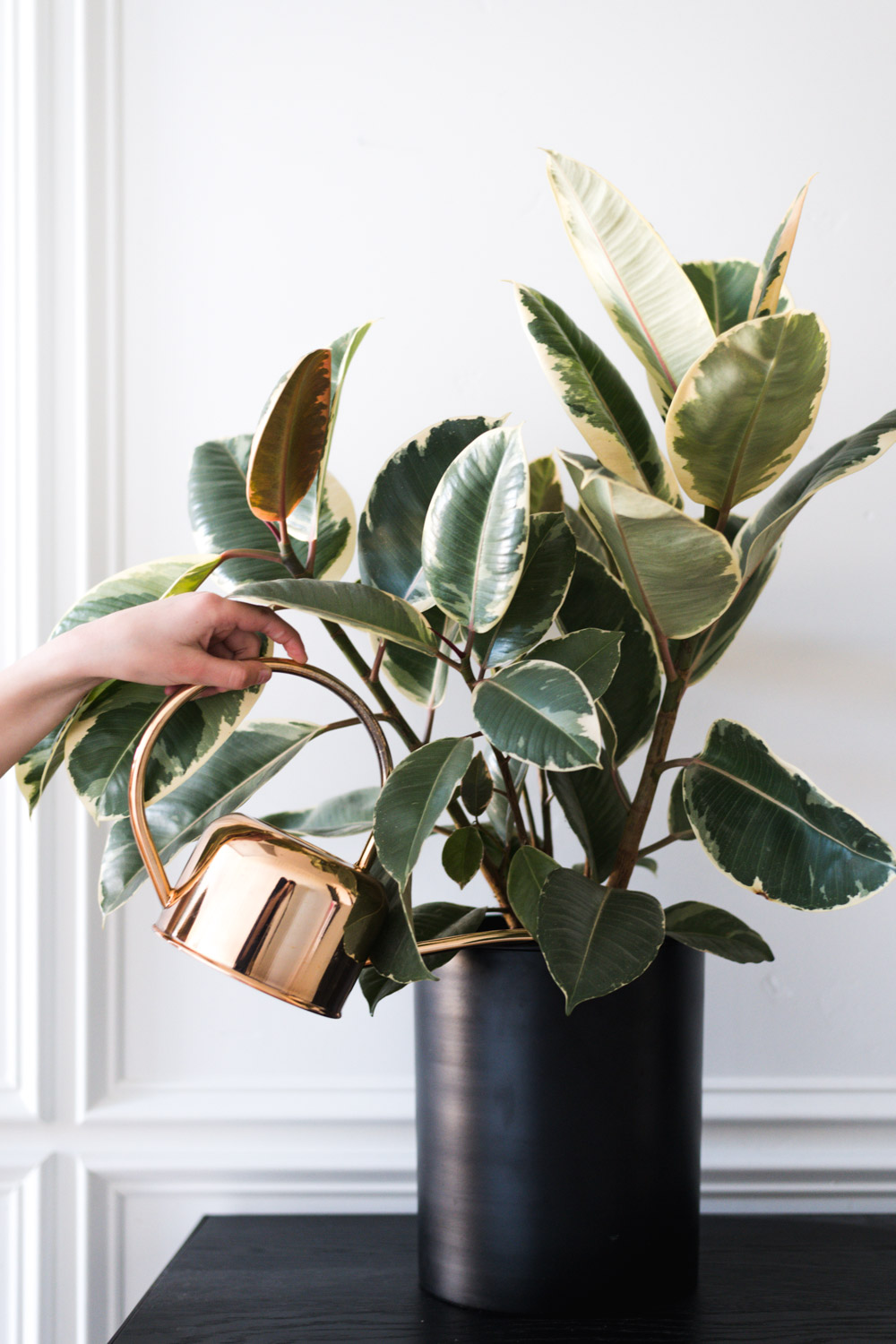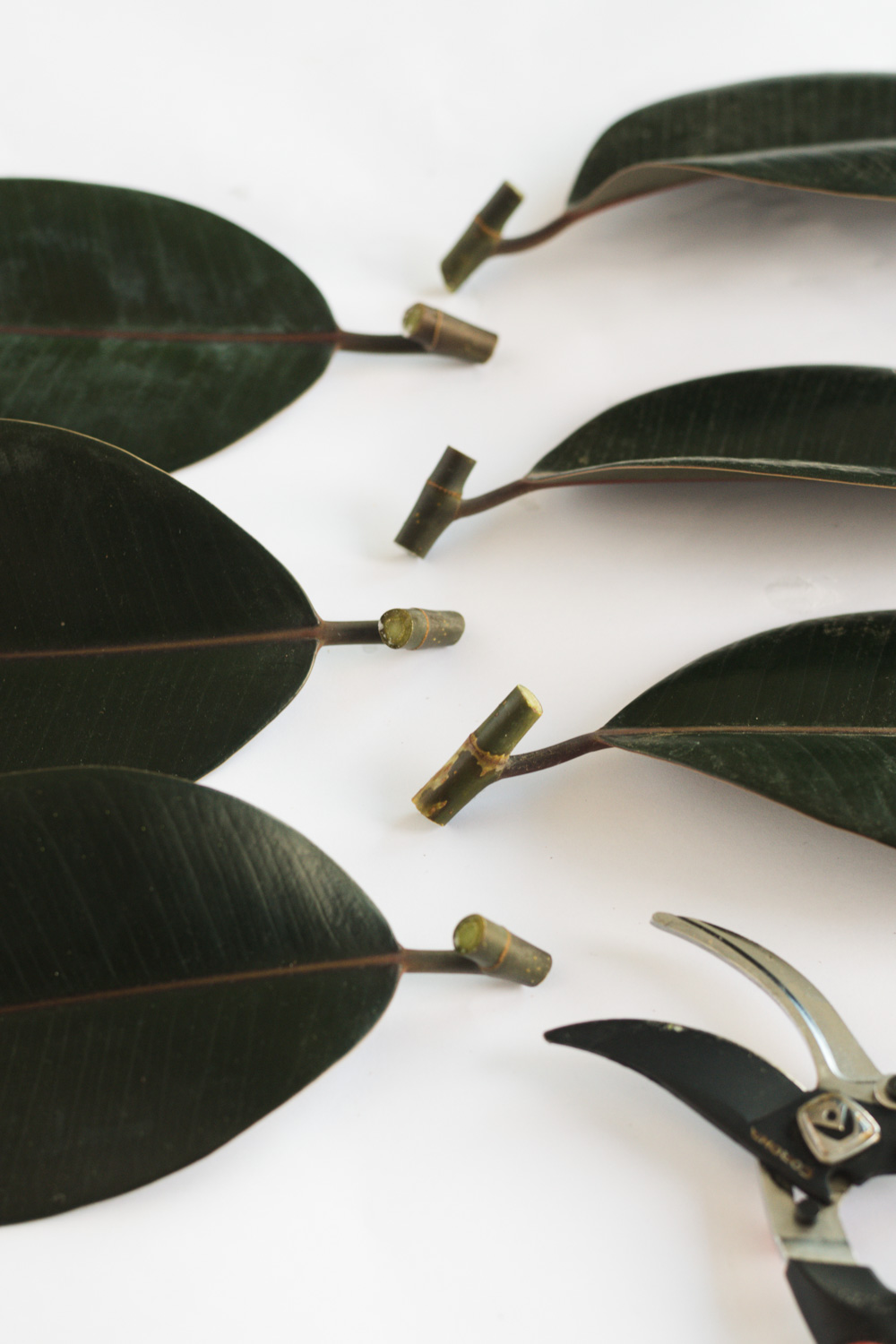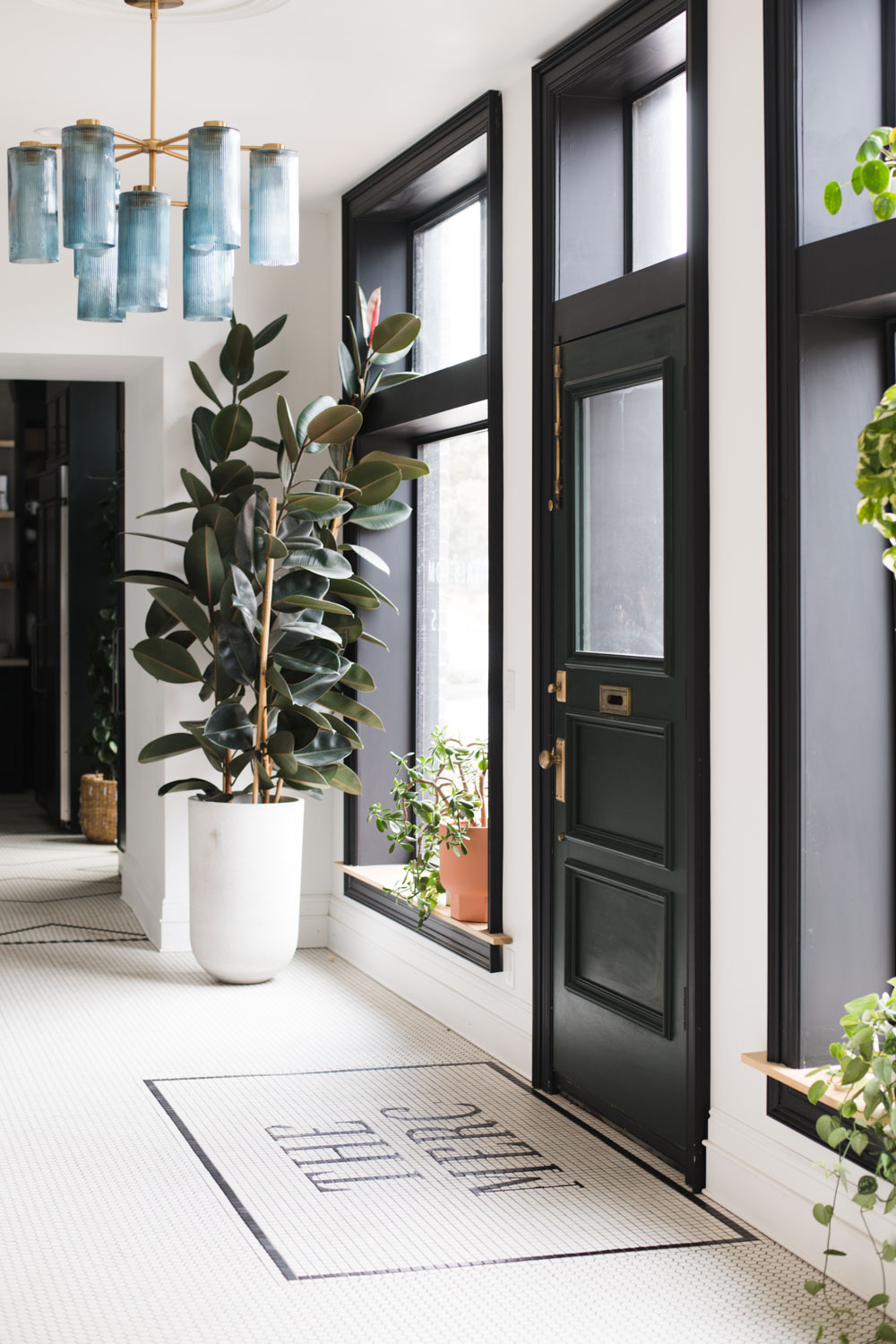
Rubber Plant or as they’re scientifically known Ficus Elastica are one of my FAVORITE indoor plants. They can be small enough to sit on your desk or so large that they touch the ceiling. They come in a few varieties (that we’ll talk about in a bit!) but regardless of if it’s a small rubber plantlet or a huge rubber plant tree this easy to care for guy is going to give you all the warm plant lover vibes! (Just make sure you treat it like a friend)

This post is chock full of everything you need to know to not only keep your Rubber Plant happy, but absolutely thriving!
Fun Facts To Keep In Mind
- Rubber Plants are not self supporting, the longer they grow the droopier they get. You can keep your rubber plant standing upright by using bamboo or dowels. I just use the leaves to hold it in place.
- Rubber Plants are quick growers, growing as much as 24″ in a season!
- Rubber plants are poisonous. They produce a milky sap when their leaves or stems are broken. This sap contains latex and can be poisonous to animals and humans.
- Rubber Plants consume their soil, so keep a supply on hand for when things get low! We’ll dive into this more later.
Anatomy of a Rubber Plant
The Rubber is a cousin to the fickle Fiddle Leaf Fig, and commands the same presence without making you cry tears of frustration.
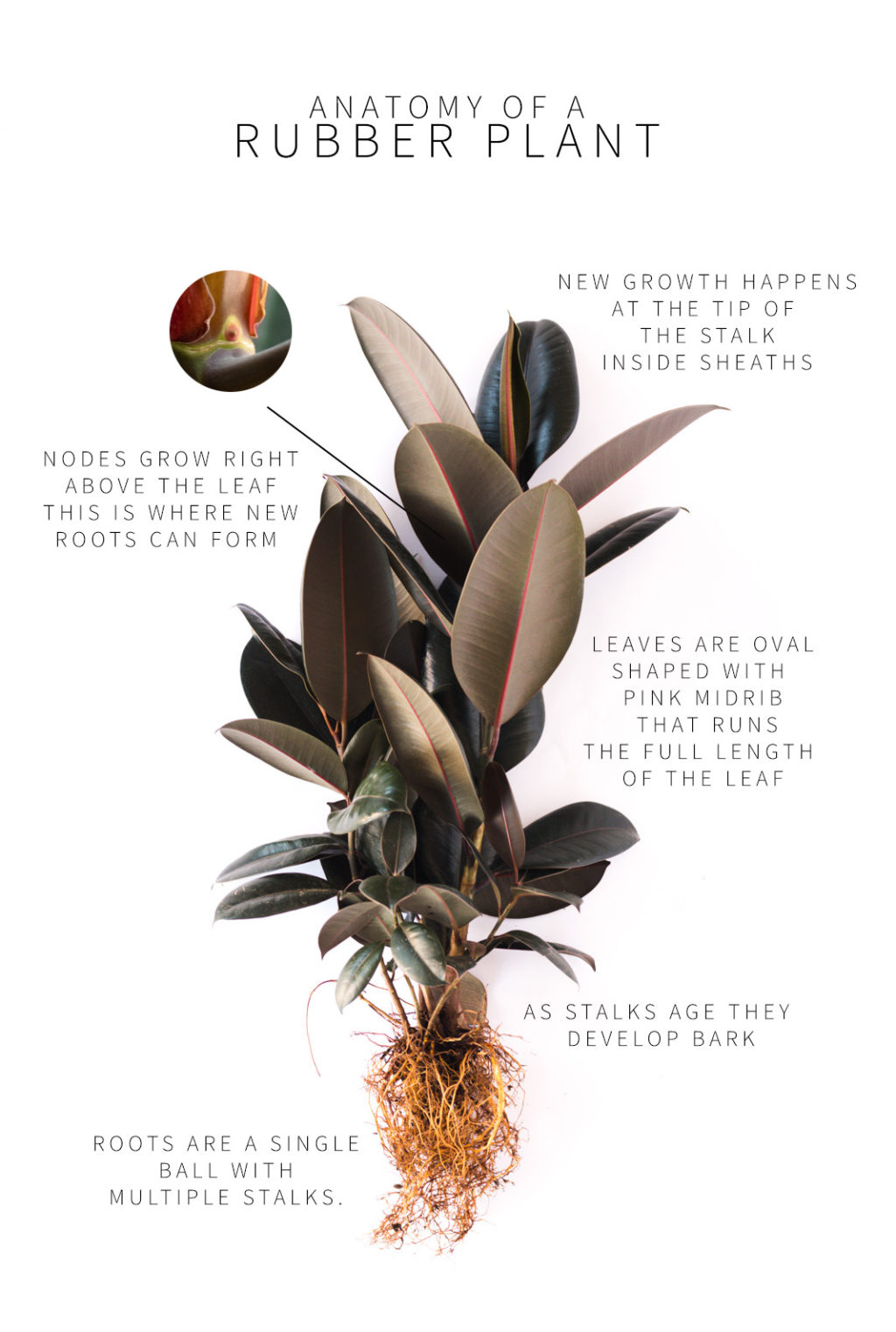
It’s thick waxy leaves start out as a soft coral and deepen to a dark green as they age. Leaves are oval shaped with thick stems that connect them to the stalk.
Rubber Plants only grow new leaves out of the top of the stalk (they don’t regrow on the sides). The new leaves are grown in a sheath. The sheath starts out as a tiny deep burgundy spike. As the leaf grows inside, the sheath lengthens and turns a shocking shade of pink. The leaf emerges from the sheath and the sheath falls off completely.
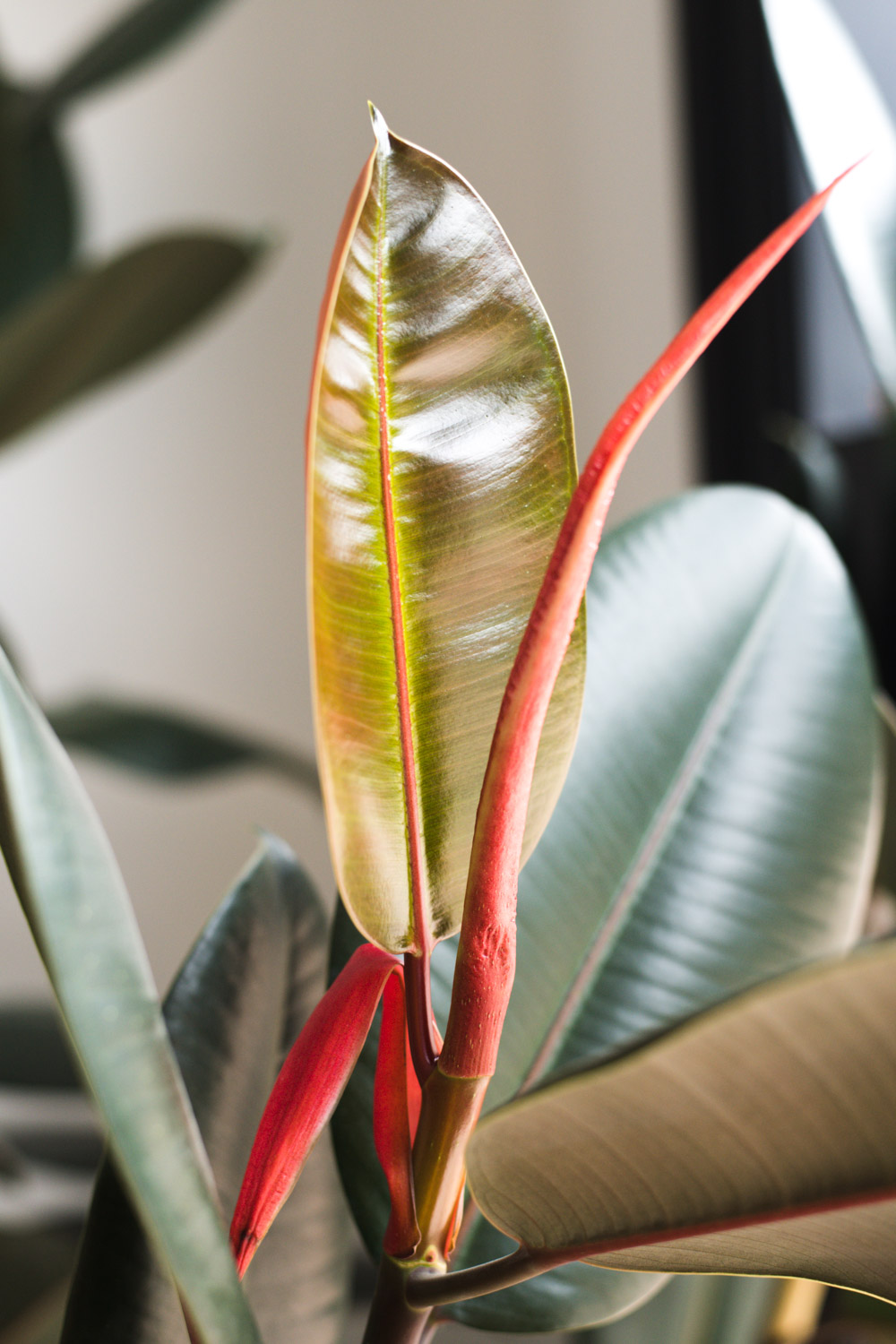
If the plant is in growth mode, when the leaf opens there will be a new sheath with a leaf growing inside!
Um, I did not know this the first time my Rubber got a new leaf. I was out of town and came home to find this pink thing on the floor. I thought my kids broke my new leaf off and heads were about to roll, until I looked up and saw this cute fresh shiny leaf. When the sheath falls off, just throw it away and don’t murder anyone.
At the base of the sheath, right above the older leaf is the node. See the little red circle? Nodes are where new roots can grow if a plant is broken or cut for propagation (which we’ll talk about in just a bit!)
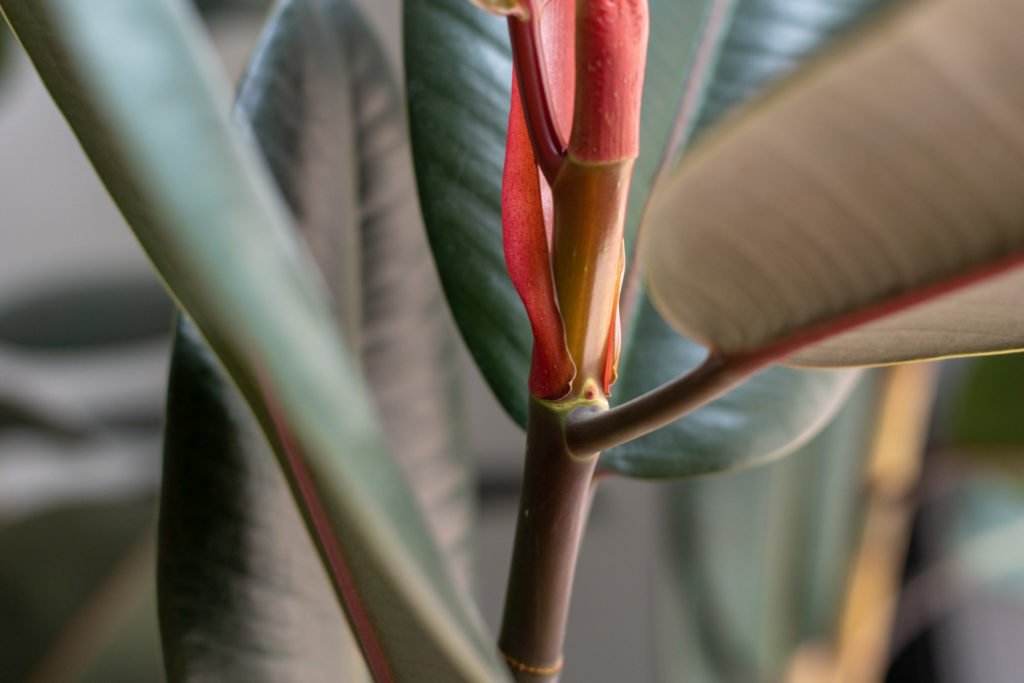
As Rubber plants grow, the older parts of the stalk develop a bark, Most indoor Rubber plants wont grow thick enough to have their stocks turn into self-supporting trunks and will need support from bamboo stalks
Variegated Rubber Plants
Variegated Rubber Plants have the coolest leaves. They are usually white and different shades of green, but can also be pink!
If you have a variegated rubber, you definitely want to avoid direct sunlight. Variegated Rubber plants are more sensitive to direct sunlight and have a harder time producing chlorophyll (what is made when sunlight is converted to sugar) so they can grow at a slower rate than their fully green counterparts.
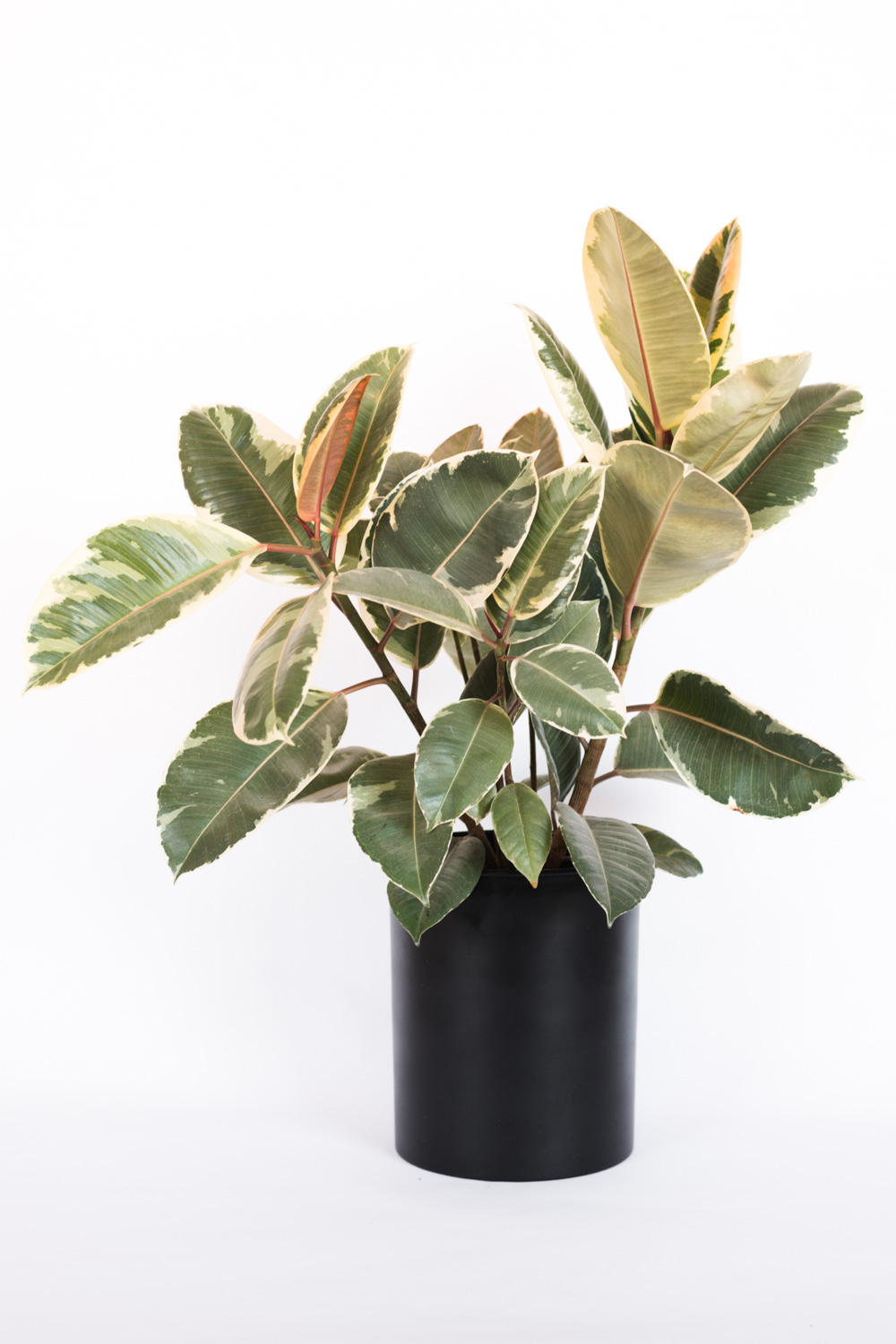
Best Lighting for Rubber Plants
Rubber Plants, like most Ficus plants love bright indirect light. The giant one that I have in my house is in a huge north facing window. If your Rubber Plant isnt getting enough light you’ll know because it can start dropping leaves (this is usually in connection with overwatering).
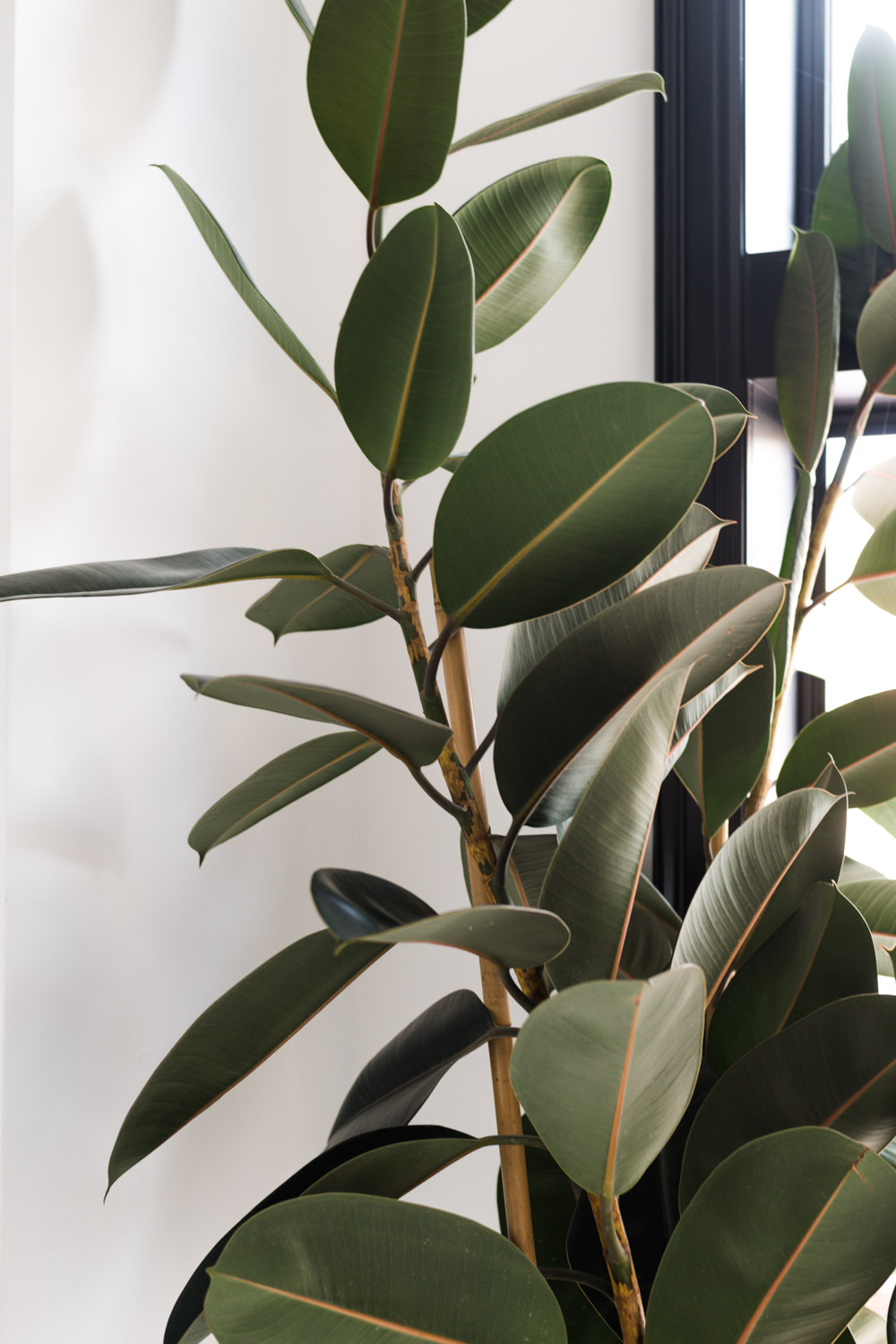
If your Rubber Plant is in a window that gets direct sunlight it should still be ok, you just might need to keep a closer eye on the soil moisture!
Wonder what kind of lighting is in your house? Take our quiz and find out!
Watering a Rubber Plant
Rubber Plants love consistently moist soil without soggy roots.
Checking the Moisture Level
You’ll know when it’s time to water when you stick a skewer (or your finger) in the soil and find that the top 2 inches has dried out. I love the skewer method because you can poke around the roots and aerate the soil so that it’s getting fresh oxygen at the roots and breaking up the compacted dirt.
How Often Should I Water?
The frequency will vary on the size of your planter, the proximity to a window, and the time of year, so by paying attention and checking the soil you should be able to stay on top of it! Water when the top 2″ of soil is dried out.
How Much Water Should I Use?
Water deeply (meaning until water drains from the holes in the planter) or until you’ve used 1/4 of the container size in water if your planter doesnt have drainage holes. This means if your plant is in a 4 gallon container, you’ll use 1 gallon of water.
Soil for Rubber Plants
Rubber Plants hate soggy roots, so a well draining soil is very important. Whenever I heard that I was always like, yes but what does that mean?! Cactus potting mix is an extremely well draining soil and can be used as a great general soil when you are replanting.
Ficus plants like Rubber and Fiddle Leaf Figs consume their soil, so watch for the roots to start getting close to popping out of the surface. When this happens, just add more soil to the top and you’ll be good for a few more months!
When to Repot Your Rubber Plant
There is a lot of confusion about when and if you should repot a plant when you bring it home. Most growers put a lot of thought and effort into the potting mix that your plants are potted in, so I would say that unless you are dealing with root rot, or your plant’s growth is stunted from the size of the planter, its totally fine to keep it in the original pot and put it inside a larger decorative one
How fast to Rubber Plants grow?
Rubber Plants are quick growers when they are in the right conditions. If you have the patience and the time, a rubber plant that starts small and adapts to your space as it grows will do even better than a large tree transplanted into your home.
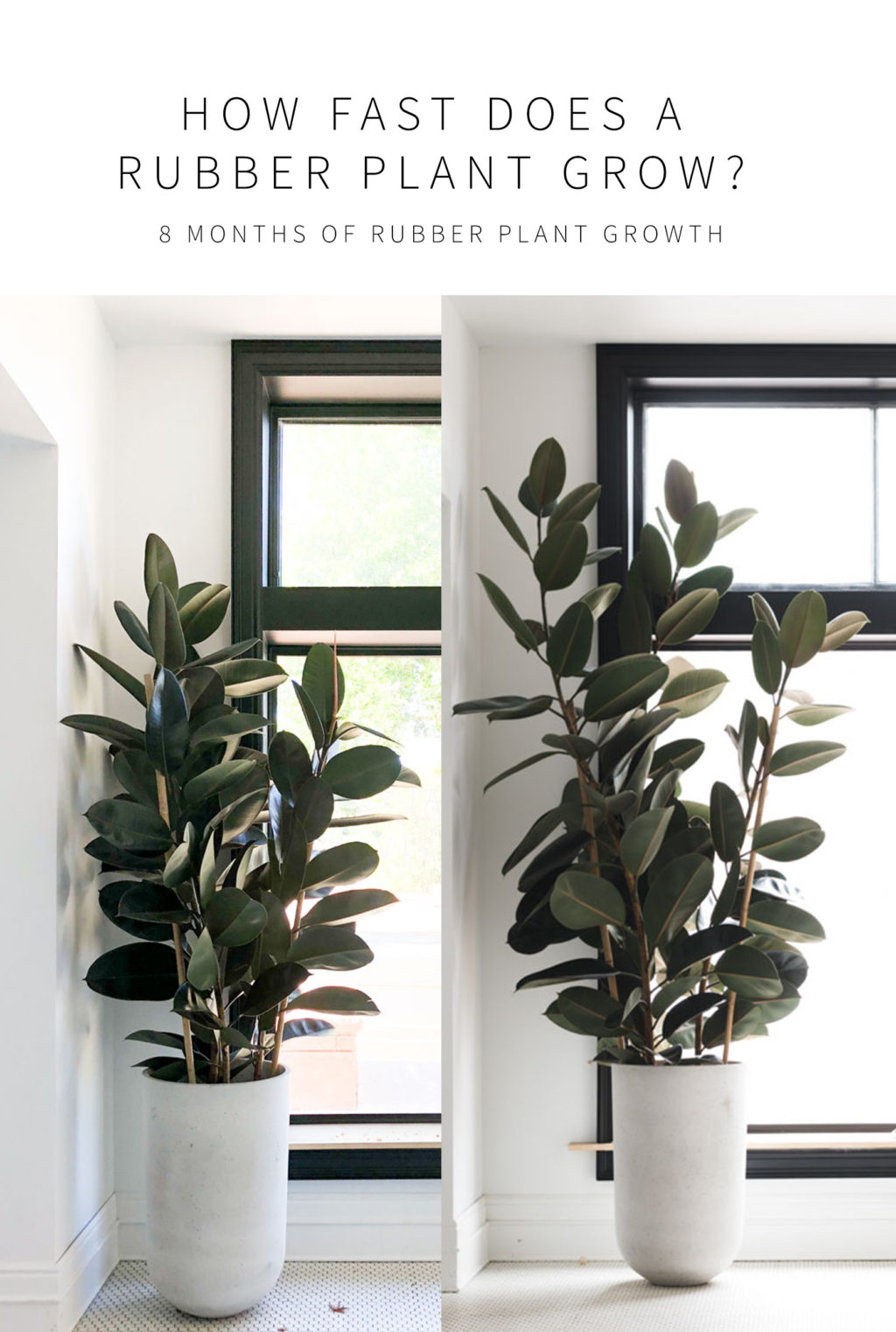
In the right conditions a Rubber plant can sprout up to 24″ in a growing season. If you plant has more than one stalk, its common to have more than one shooting up at the same time. My big guy has 3 stalks and when it’s blooming, 2 of the stalks are usually growing at the same time.
Sidenote:
If you notice that your Rubber Plant’s leaves are standing vertical, it is probably because it’s turned them to face the sun. This is totally normal and can be corrected by simply rotating the plant so that the light is hitting it differently! Notice the leaves in the photo below, see how so many of them are standing vertical? The plant needed to be rotated!
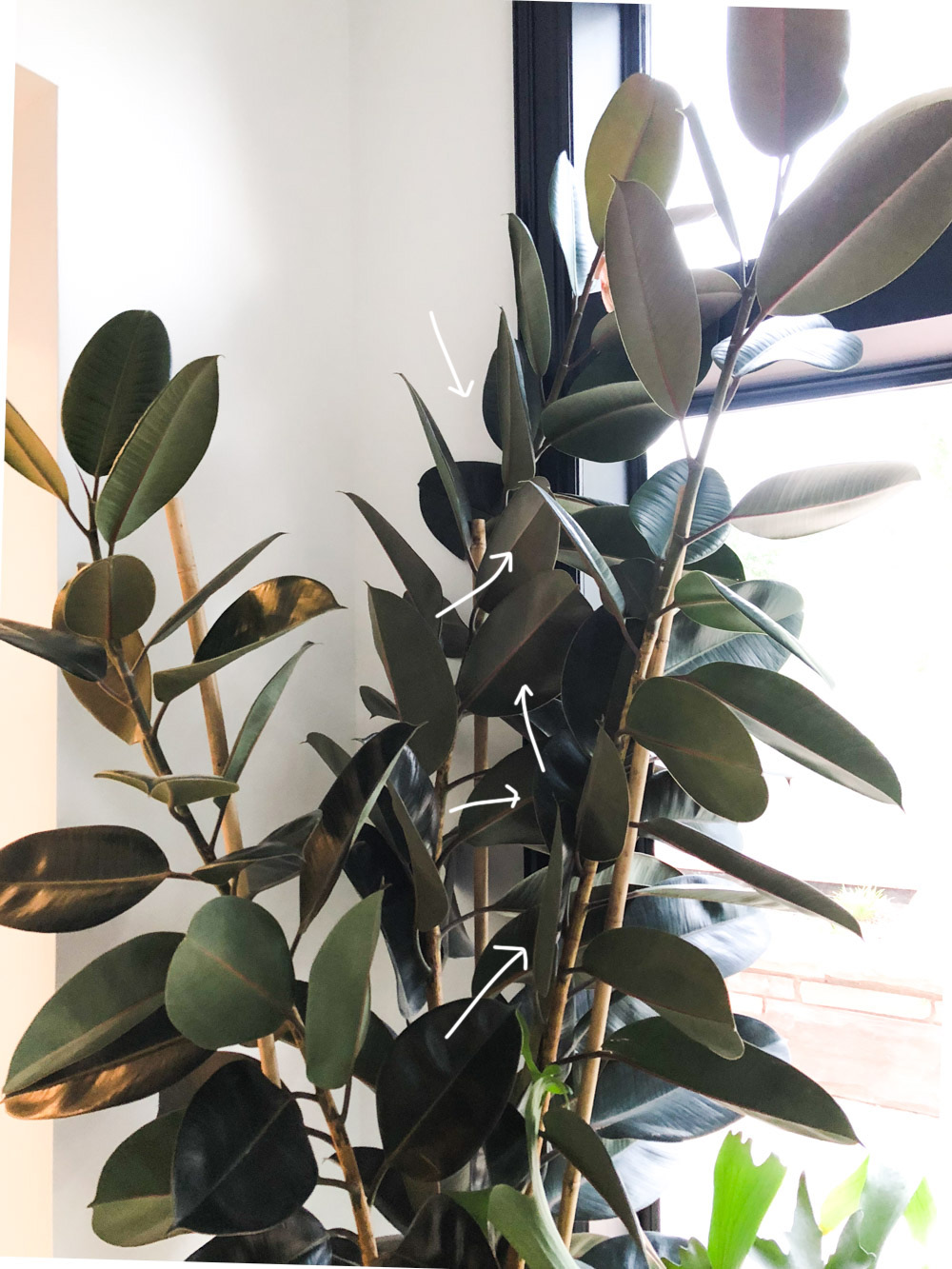
How to Propagate a Rubber Plant
Rubber plant propagation is really easy! Nodes can root in water or soil. Propagate from wood parts of the stalk?
Step 1: Cut the Stalk
Cut the stalk between the leaves, you can get multiple starts from one stalk!
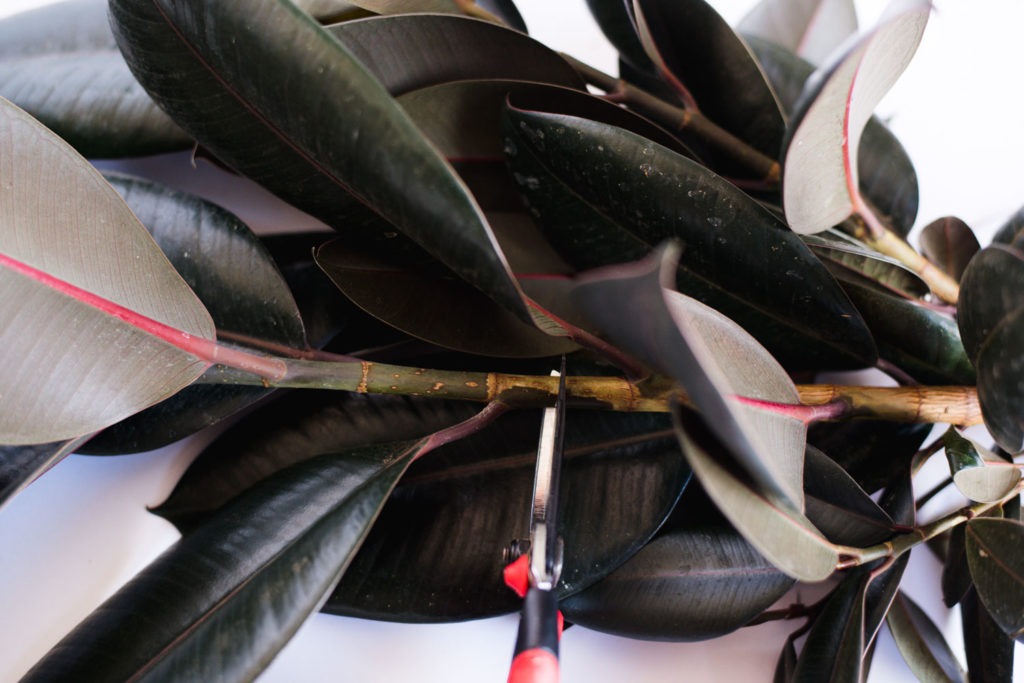
Remember, the node is right by the leaf! Each cutting should have a small portion of stalk and a leaf on it. 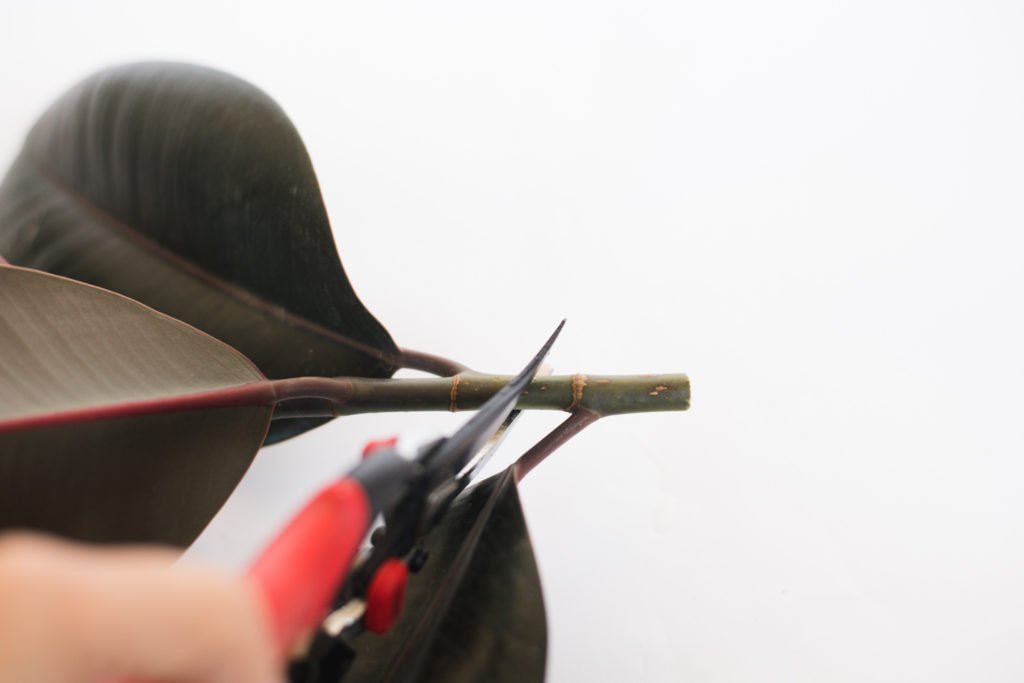
Step 2: Wash the white sap off of the cuttings
You can also dip the ends of the cutting in rooting hormone or honey to encourage root growth.
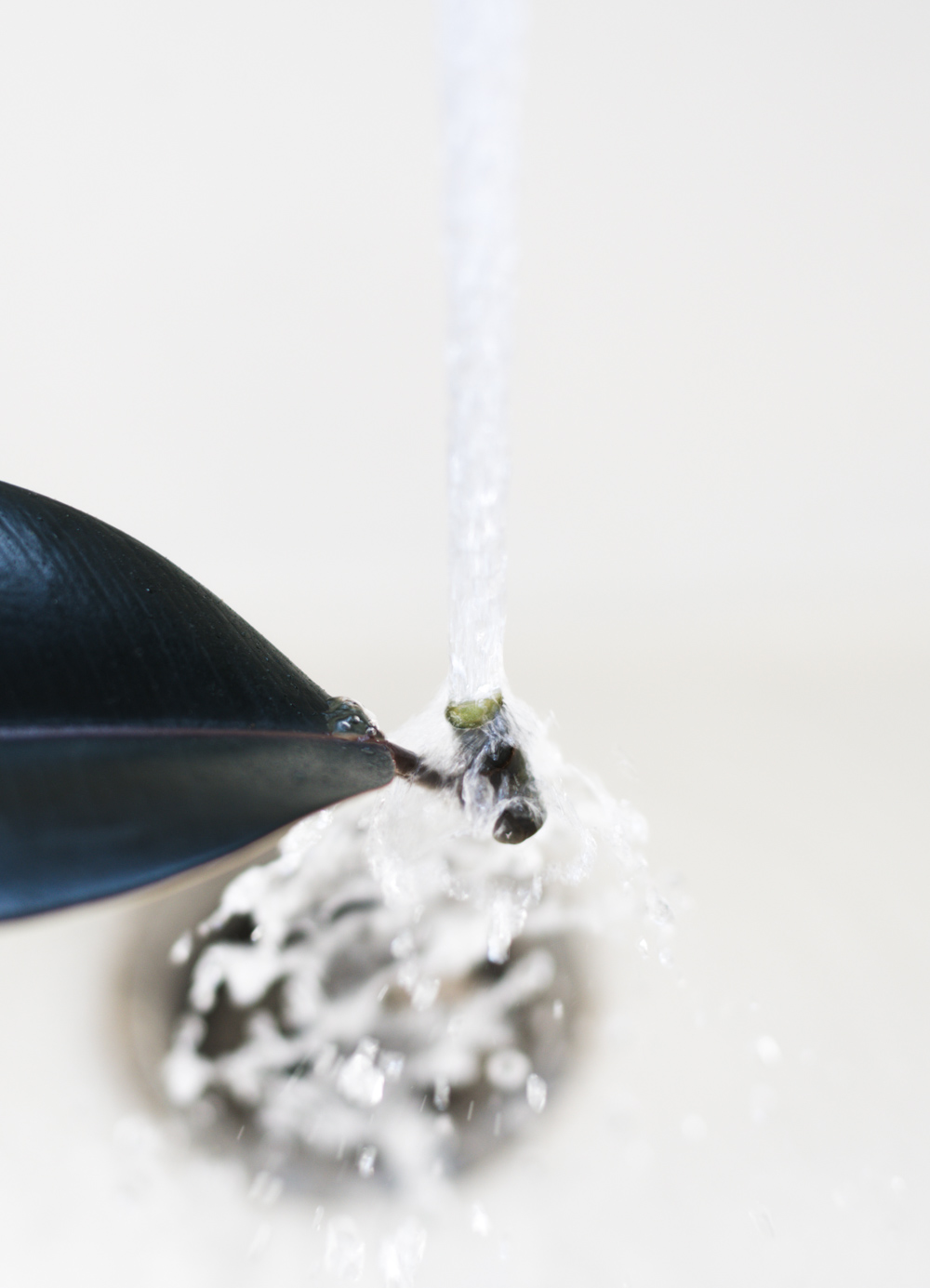
Step 3: Place the cutting in water (or soil)
Just make sure that the node stays covered!

Step 4: Replace the water every few days.
Fresh water has oxygen in it that the plant needs! Check for root growth! It can take a few months for the cuttings to root, dont get discouraged, as long as your leaf is still alive, things are happening!!
Step 5: Plant the Rooted Cutting in Soil
Congrats!! Once your Rubber Plant has rooted it’s time to put it in soil! Use a well draining mix that we talked about earlier in this post and watch it thrive!!
How to Clean Dust Off of Leaves
Plants with large leaves can get really dusty, this is a problem because like solar panels, leaves are the way that the plant absorbs light. If the weather is nice outside, take your Rubber Plant out and gently hose it off. Think of how rain would hit it and do it that way! This should clean off most of the dust! If the grime is a little thicker, or if you arent able to move your plant outside, use a baby wipe to wipe them down! You can buy sprays that make the leave extra shiny but I tend to steer away from them because they make the plant look fake.
Are Rubber Plants poisonous?
Rubber Plants are considered poisonous. They produce a milky sap that contains Latex that can be harmful to human and animals. But don’t freak out. They are classified as Toxicity Class 4- which is the most mild classification- meaning no one is going to die. The sap can cause minor skin irritation to larger rashes.
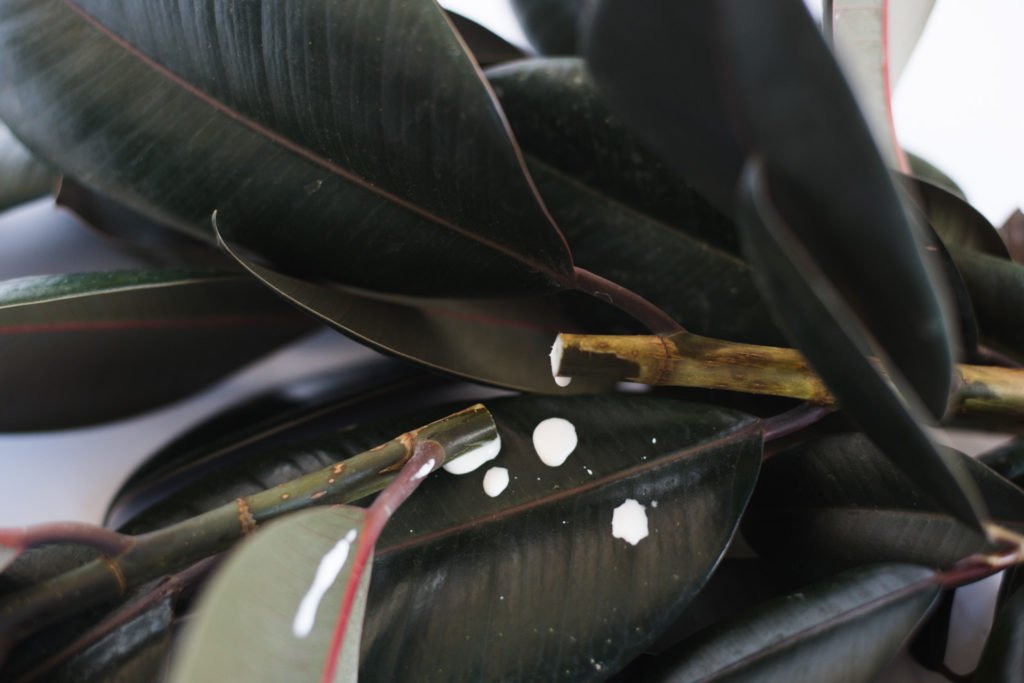
My Rubber Plant is Leggy (Can it Regrow Leaves?)
When Rubber Plants drop leaves they can become leggy, meaning there are no leaves on the lower part of the plant. Rubber plants do not regrow leaves from the lower parts of their stalks, only from the top. So there is no way to make a plant less leggy.
To make your Rubber Plant appear fuller you’ll need to replant smaller stalks in the planter with the larger ones. This will fill out the lower naked space make the plant look bushier.
HELP!! What is Wrong with My Rubber Plant!?
One of the best things about social media is crowd sourcing, as I was writing this post I thought- wouldnt it be cool if we could see real life scenarios where Rubber Plants are struggling, and diagnose what is happening so everyone can learn from it?! So I posted on Instagram and got the best pictures! I’ve got my bestie plant expert Shane in the house to break down what is happening and how to fix it!
Leaves are turning yellow and falling off
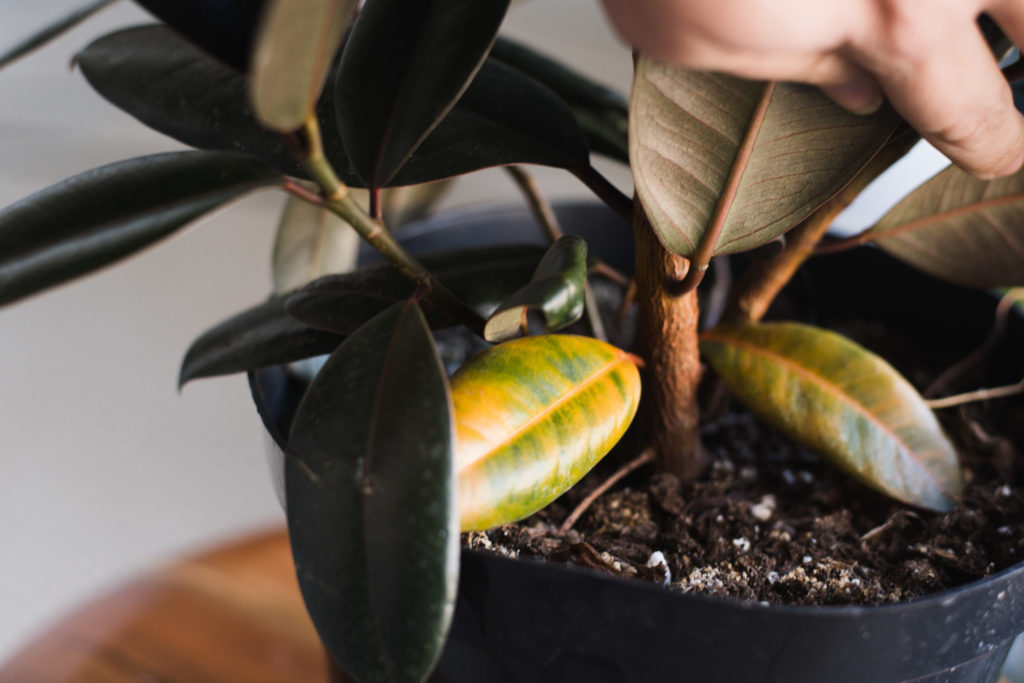
If the leaves are lower like they are on this plant, its because the plant is using up all of its energy for new larger growth. These guys arent getting as much light because they are hidden underneath the larger leaves, and 2. they were the first leaves sprouted and so they’ll be the first to die off as the plant grows. If the rest of the plant seems healthy and there is new growth happening (like there is on this one) don’t worry about a few leaves dying.
If the leaves are higher on the plant, or they are larger new growth, your Rubber Plant is drowning! Cut back on the watering and give it a chance to breathe. You wont be able to save the yellowed leaves, but you can keep it happy moving forward!
Lower Leaves Are Dropping
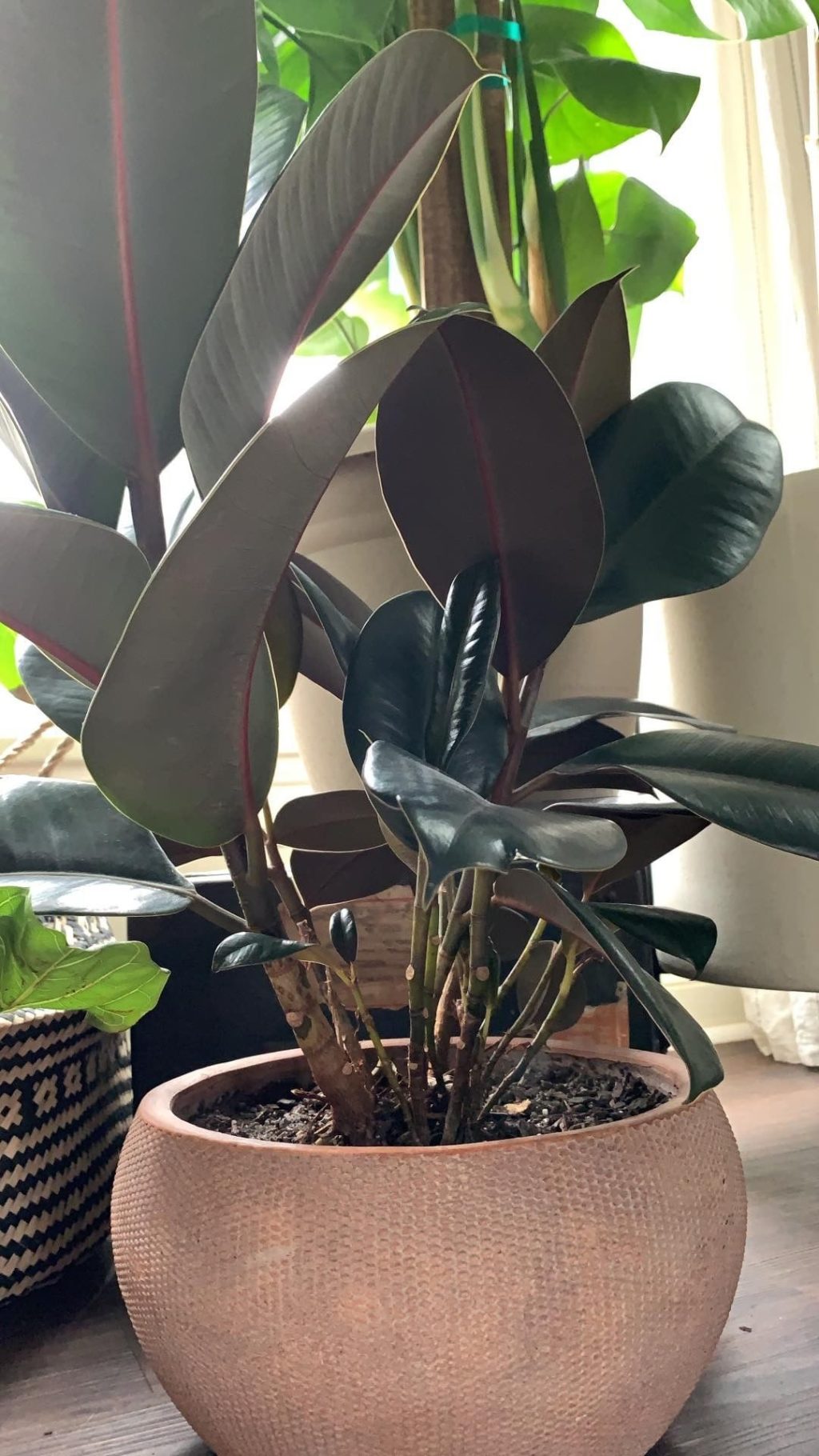
If your Rubber Plant is dropping lower leaves, especially when it’s new in your home, dont worry! This is your rubber plant getting used to it’s new environment. Make sure that it has adequate light and everything should stop. If they aren’t, look for other signs as to what could be wrong!
Solution: If this is the only thing happening, it’s totally normal!
Leaves are Droopy
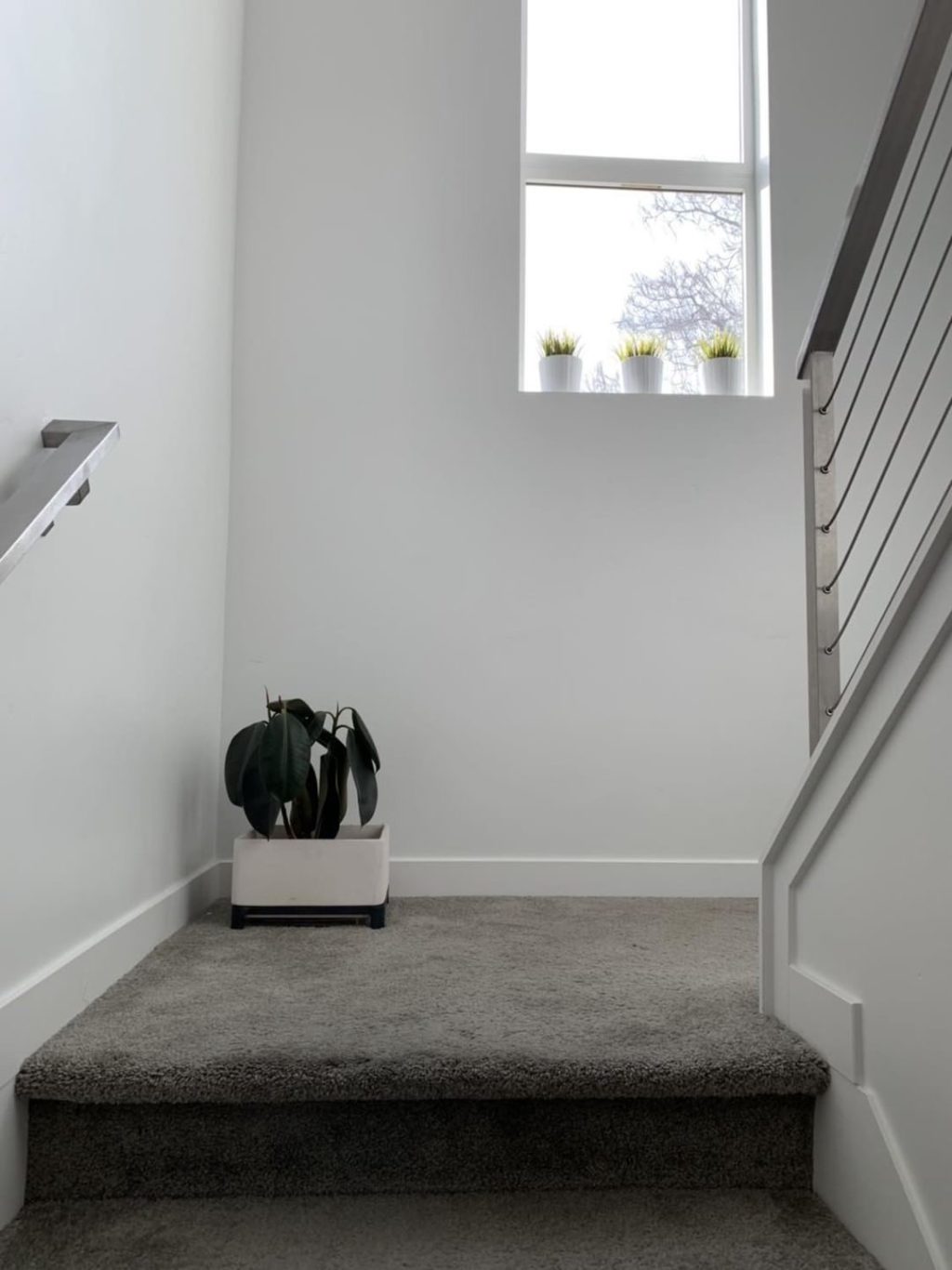
The problem with this little guy is that he’s not getting enough sun! The window isnt casting much natural light and he’s in the corner away from where it would likely shine even if it was. Chances are that it is also being overwatered. When light cant reach the plant, they go into hibernation mode and absorb water less quickly.
Solution: Move this plant to a different spot where it wont be missing the sunshine!
Leaves are Turning Brown and Dropping
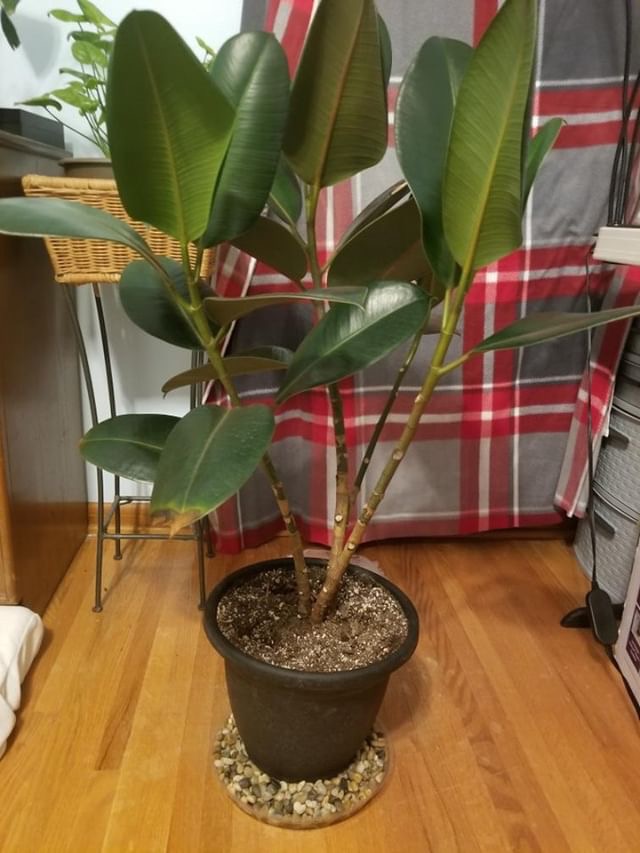
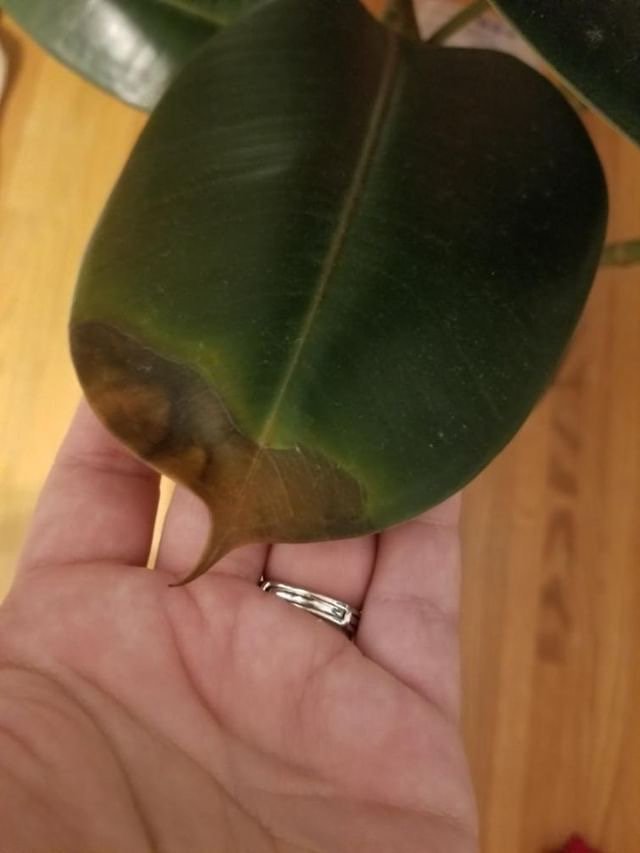
This is a watering issue. This reader is going too long between waterings. Usually if leaves turn brown and crispy the Rubber Plant isn’t getting enough water. So what is happening is that the leaves start to dry out and they drop when the plant decides that it needs to put all of it’s energy into saving the living leaves. It is also likely not getting enough light.
Solution: Make sure this plant is receiving regular waterings and that the soil is constantly moist.
Leaves are Droopy, Yellow and Brown and Dropping
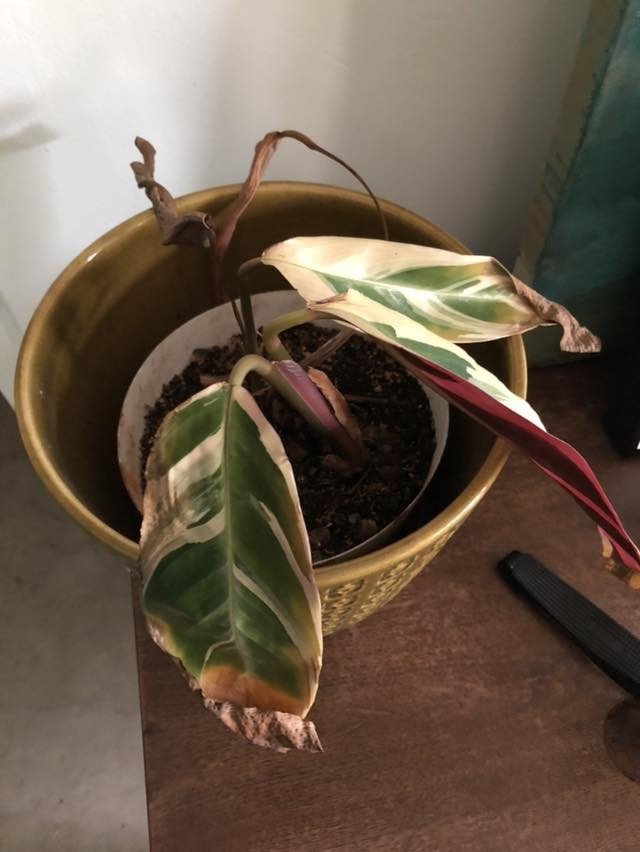
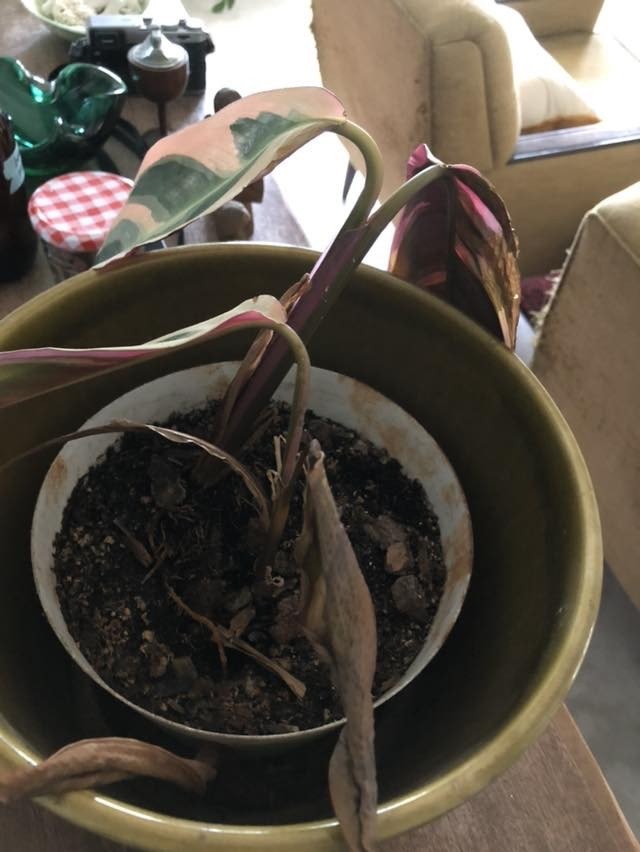
This is a soil issue. The soil seems to be compacted which means that the soil has dried out completely at some point and formed sort of a crust. New water struggles to get absorbed and the roots are suffocating.
Solution: You can tell that your soil has dried out if it has pulled away from the container. If this is the case, aerate it with a skewer before you water so that it’s getting all the way to the center of the root ball. If you just pour water on it without breaking up the compacted soil it will just run down the sides of the root ball and out the bottom of the planter.
Stalks are Very Thin and Long
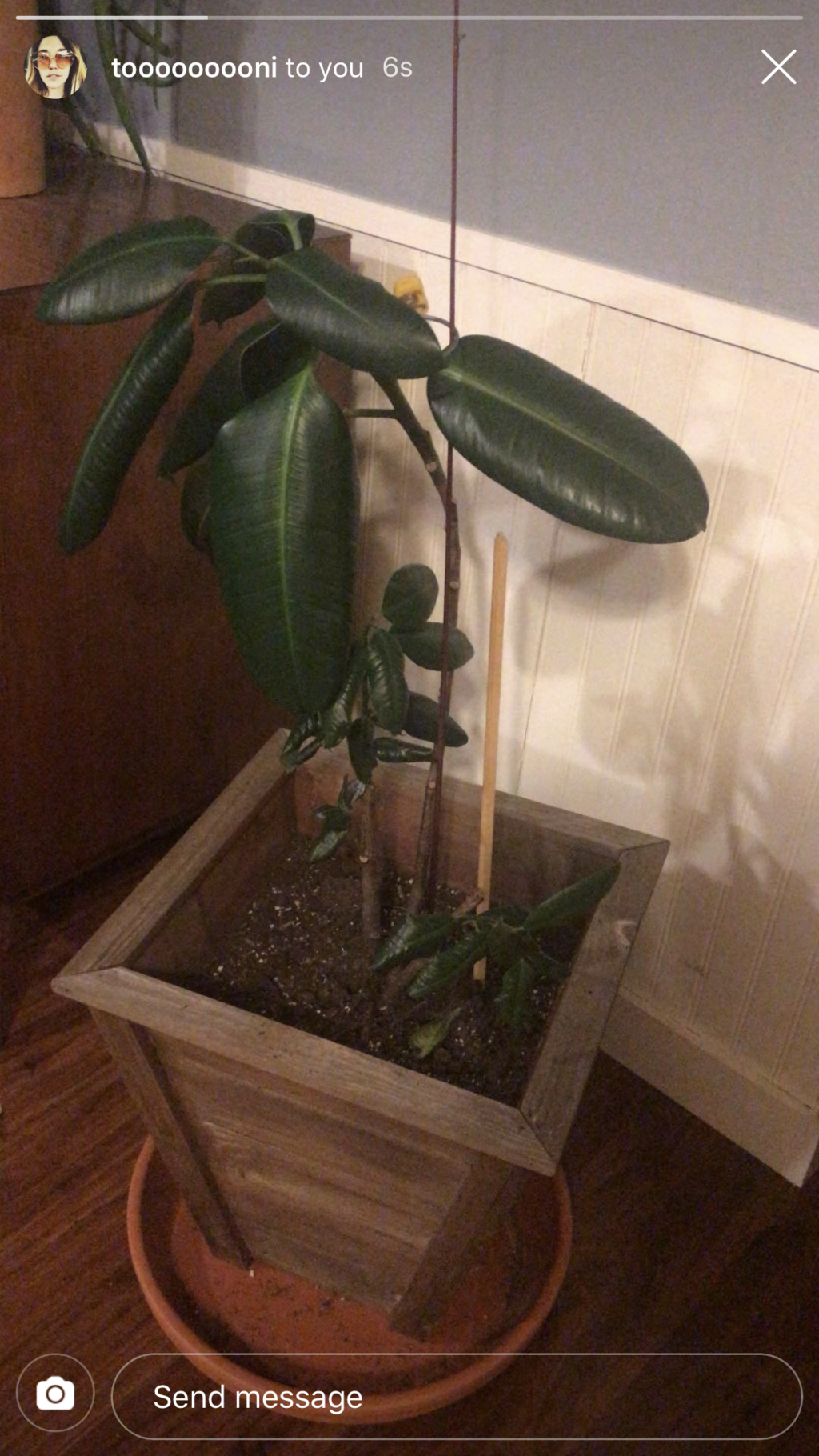
Rubber plants that live indoors will almost always need support, even my tall healthy one has a bamboo support for each stalk! But the issue with this guy is 2 fold. Lack of light is causing it to shoot higher to find any light source, which is why the stalks are so thin.
The second issue is that it’s not getting enough water. See how the leaves are curling back? That is an indicator that it’s thirsty! It might have something to do with the wooden planter that it’s in. The wood might be absorbing a huge portion of the water before your Rubber plant has a chance to! Consider swapping it out for something less absorbent like ceramic, plastic, or glass.
Where to Buy Rubber Plants
You can often find Rubber plants at your local Home Depot or Lowes. They’ll most likely be smaller one though. If you are looking for something larger check out your local indoor nursery. If you’re in Southern Utah you’ve got to go to Moss and Timber! They are my favorite!!
Now you are FULLY prepared to have a thriving and happy Rubber Plant in your home! Welcome to the club my friend!!
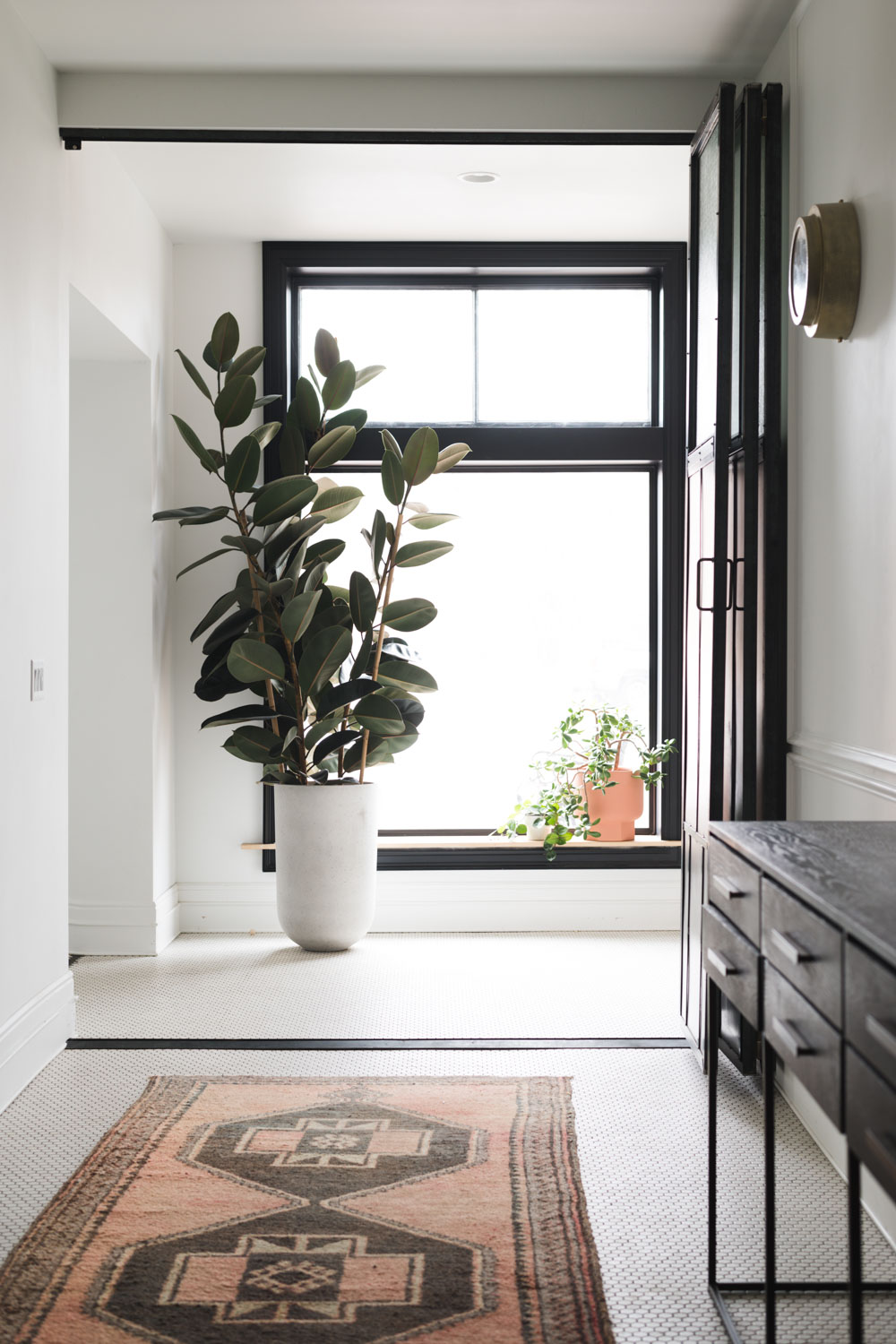
Also, PHEW that was a lot of info! Did I miss anything? Leave your questions or comments below!!
The post A Complete Guide To Caring For Rubber Plants and Answers to Why Yours Might Be Dying appeared first on Vintage Revivals.
via Mandi at A Complete Guide To Caring For Rubber Plants and Answers to Why Yours Might Be Dying
